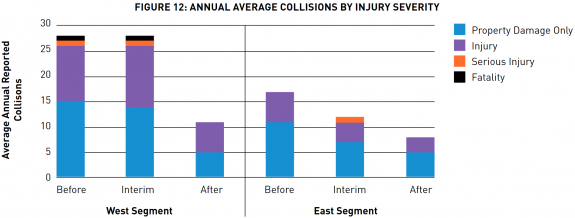
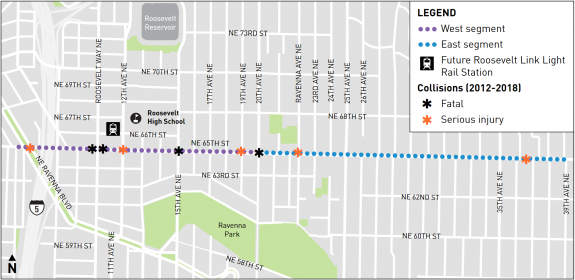 For a four-year period, the short stretch of NE 65th Street between NE Ravenna Blvd and 39th Ave NE killed one person and seriously injured at least one other person every year. But a hard-fought safety project installed in spring 2019 has cut collisions by more than half and has so far eliminated deaths and serious injuries, according to a new SDOT report (PDF).
For a four-year period, the short stretch of NE 65th Street between NE Ravenna Blvd and 39th Ave NE killed one person and seriously injured at least one other person every year. But a hard-fought safety project installed in spring 2019 has cut collisions by more than half and has so far eliminated deaths and serious injuries, according to a new SDOT report (PDF).
As with nearly all of SDOT’s Vision Zero street redesigns, the project is a huge success. It once again demonstrates the department’s ability to save lives and improve mobility when it prioritizes safety on our streets.
There is at least one person somewhere who is sipping coffee, Zoom chatting with a loved one or otherwise living life at this moment who would be dead if not for these safety changes. Is it your friend? Your mother? You? We will never know who that person is, but we do know that had the city chosen not to take action and make changes to this street, one person would die every year. And that person would most likely have been walking or riding a bike.
And these benefits come even though the city compromised fairly heavily on many of the details. For example, intersections do not have separated signal phases for people on bikes and bike lanes share space with bus stops in several locations. And worst of all, the bike lanes stop at 20th Ave NE, providing no dedicated biking space between 20th and 39th. But even with these compromises and half measures, the results are impressive.
And the problems that led to traffic danger on this street were not at all unique to NE 65th Street. They are problems repeated on streets all over the city and the region. Too much space for cars leads to speeding and no space for people biking or crossing the street leaves them vulnerable.
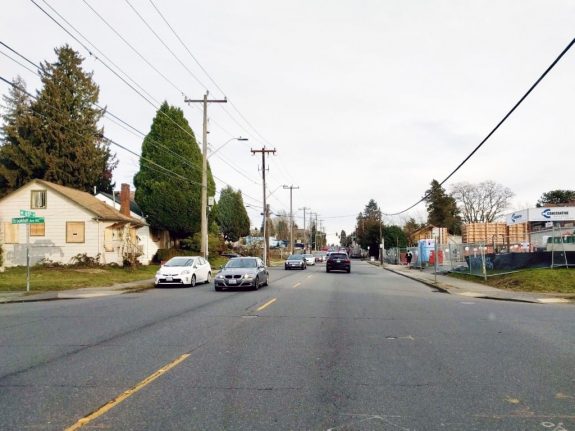
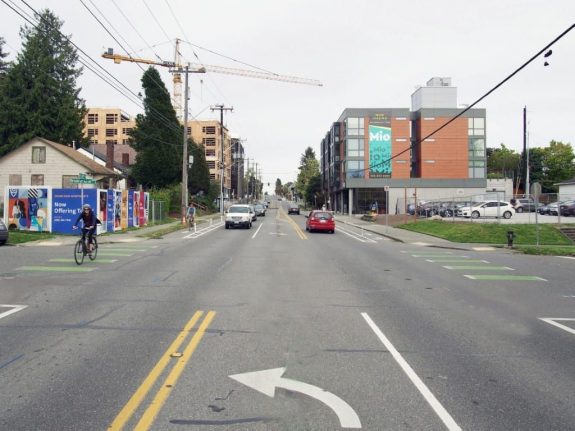
There’s a very good chance that the “before” photo looks very familiar even if you’ve never been to NE 65th Street before. That’s just how streets were designed for the better part of a century, giving all the space to general traffic. This street design has proven to be a horrifically deadly mistake. Someone walking or biking across the street is essentially exposed to car traffic danger from one curb all the way to the other. The longer someone is in the path of moving cars, the more likely someone else will hit them with a car. This is not rocket science. It’s very simple. By building bike lanes and a center turn lane, someone crossing the street is only exposed to through-traffic for about half the distance as before.
We know that wide lanes encourage people driving to speed. But worse, the very wide lanes on NE 65th Street allowed people who wanted to speed to drive around people who were driving safe speeds, which introduced many dangerous passing scenarios. So SDOT better defined the travel lanes and made them skinnier, and speeding declined.
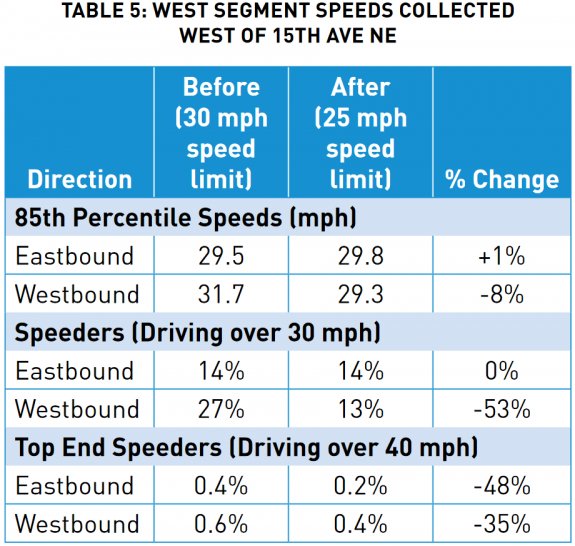 So not only are there fewer than half as many collisions now, but the collisions that do happen occur at slower speeds. This safety double-whammy is why these Vision Zero projects are so consistently effective and repeatable. Stone Way, Nickerson, NE 125th, Rainier Ave, and on and on.
So not only are there fewer than half as many collisions now, but the collisions that do happen occur at slower speeds. This safety double-whammy is why these Vision Zero projects are so consistently effective and repeatable. Stone Way, Nickerson, NE 125th, Rainier Ave, and on and on.
And so it is on transportation departments to take what we now know about traffic safety and make changes to these streets so they are safer for everyone. This is the mission of SDOT’s minuscule Vision Zero program, but it should be the primary mission for the whole department and for transportation departments all over the region and state.
It’s beyond time to reframe how we think about these Vision Zero projects. The question isn’t “Should we make this street safer?” The question is “How can we justify allowing people to be injured or killed on this street when the we know how to fix it?” The onus shouldn’t be on safe streets advocates to organize protests to get safety fixes. The onus should be on safety project opponents to make the case that people dying and being seriously injured is a justifiable cost for maintaining the status quo.
These are the same results that would have happened on 35th Ave NE had Mayor Jenny Durkan not cancelled that project’s safety upgrades at the last minute. Like with 35th, there was enormous resistance to the safety project on 65th. I attended a brutal 2013 public meeting in a packed gym just blocks away from this now-safer street in which people yelled at then-Mayor Mike McGinn for an hour because the under-development Bike Master Plan called for these bike lanes. It was very well-organized and full of misinformation and fear-mongering about all the ways the bike lanes would destroy the neighborhood.
“A cycle track is not a fuzzy teddy bear, it’s a dream killer,” said the opening speaker to applause. The bike lane was going to close all the businesses, prevent friends and family from visiting each other and might actually kill people because ambulances wouldn’t be able to park with the bike lane, people claimed. Of course none of this was true just as it wouldn’t have been true for 35th Ave NE had the Mayor Durkan backed SDOT’s plan there. Neighbors calling on the city to #Fix65th deserve a ton of credit for staying organized and dedicated to making this project happen even in the face of tough opposition. I really hope people who attended that 2013 meeting to oppose bike lanes get to see these results and think about how they can avoid being mislead into fighting against safety projects in the future.
Of course, the project is far from perfect. The design includes several compromises that safe streets advocates fought against. And there were still three reported collisions involving people biking after the project was completed, though luckily none were serious. All of them were at intersections without a protected intersection design such as a dedicated bike signal phase. Two were at 12th Ave NE and one was at 15th Ave NE. The study does not say how these collisions occurred, but hopefully SDOT is prepared to make spot fixes as needed to keep everyone safe.
There was also a mid-block collision involving someone biking between 24th and 25th Avenues NE where the city chose not to build bike lanes.
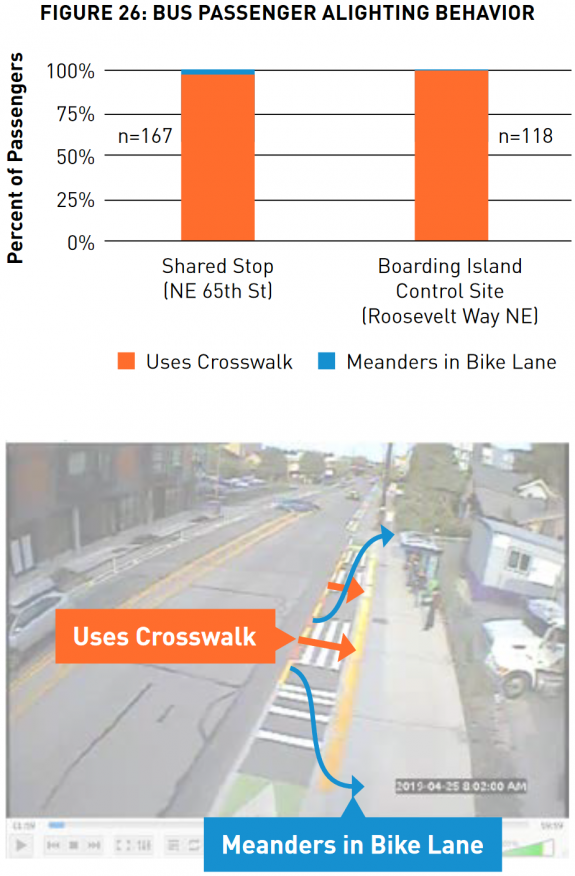 The project is also serving as something of a trial for a combined bike lane and bus stop design concept. This project created four of these “shared stops,” which are a little unusual because people entering and exiting buses do so in the bike lane. People biking are supposed to stop and wait while buses are loading, and people waiting for buses are supposed to leave the bike lane open when waiting. SDOT and Metro are monitoring how the lanes are working, and so far there have not been any serious issues.
The project is also serving as something of a trial for a combined bike lane and bus stop design concept. This project created four of these “shared stops,” which are a little unusual because people entering and exiting buses do so in the bike lane. People biking are supposed to stop and wait while buses are loading, and people waiting for buses are supposed to leave the bike lane open when waiting. SDOT and Metro are monitoring how the lanes are working, and so far there have not been any serious issues.
“The new shared transit stop design operated as intended with no reported operational or safety issues,” according to the report. “This shows that the design can be successful at locations with lower volumes of bike traffic and moderate levels of passenger activity. It will be important to continue to monitor the operation of these designs when the North Link Roosevelt Light Rail Station opens and bike and passenger volumes increase.”
It’s not clear how well this design will work on a busier street, but the results are promising. I had my doubts about this design, and I’m glad that those fears so far seem to be unfounded.








Comments
8 responses to “Report: NE 65th Street bike lanes have saved lives and prevented serious injuries”
Note about bike lane shared with bus stop: I was in Copenhagen a year or so ago and rented a bike one day. Mostly I rode out of town to the north, which was quite a wonderful experience. Back in town, though, I did notice they have some locations where the bus stops outside the bike lane and people have to cross to get to the sidewalk.
Now, I don’t know what percent of people on the bus were locals versus tourists, but I’ll guess virtually all were locals. Sure enough, a bus started to disgorge passengers and several started to cross in front of me without looking. I slowed down and they also did end up noticing and stopped. But I think it’s very easy to forget, especially if the shared stop is an anomaly rather than a consistency.
This is a good point, and Metro actually has an automated announcement for the route 33 stops in Magnolia along Gilman where bus riders have to cross the bike lane immediately. I’m not sure why the 62 doesn’t have similar announcements, since 65th has many more pedestrians and the 62 has many more riders than anything in Magnolia.
In Copenhagen cyclists are supposed to yield to people getting off the bus – so they were likely acting under the assumption that you were stopping for them.
The bike lane from Ravenna Blvd. to 20th is great, very helpful, but heading east the bike lane ends at a particularly bad spot, at the intersection of 20th Ave. NE and NE 65th St. The road descends at that point for a half block or so, into the section of 65th that has several business on either side of the street.
This creates a bad choke point as the road narrows (parked cars) and traffic speeds up going down the hill. There is also a bus stop on that downhill section and if there is a bus pulled over letting passengers off, or trying to re-enter traffic, it makes the whole situation even messier and more dangerous. I have experienced many close calls in that part of 65th on my commute home in recent months.
I have tried taking the lane but have gotten aggressively tailgated, then aggressively passed on quite a few occasions. Staying over to the right isn’t any better as drivers accelerate and try to squeeze past when there really isn’t a gap.
After you cross 25th and start slogging up the hill on towards 35th Ave. NE it’s more of the same. You’re moving slowly (or at least I am, it’s about a 7 percent grade) and with parked cars to your right you have to take some of the lane in order to stay out of the door zone. As a result, there is more passive aggressive accelerating and passing (often way too close).
But wait, there’s more! Bombing down the backside of that same hill, on NE 65th St from 35th Ave. NE down to the Neighborhood Greenway on 39th Ave. NE, I find that even though I am doing 25 mph or more (not difficult, it’s a steep downhill), I still encounter drivers trying to pass me, even though it is often risky for them to do so. Towards the bottom of that hill there has been a huge RV parked for some months (on the Eastbound side of the road) and it creates a big blind spot for drivers pulling out of the side streets. Also, there is a pedestrian island (where the Greenway crosses 65th) just after the RV so between the two there is a bad choke point, just as the aggressive drivers are trying to pass. I’ve had quite a few “moments” there in the last few months.
I’d say that NE 65th St is pretty bike friendly for about 40% of it’s length from Ravenna Blvd. to 39th Ave NE. For the majority of though (East of 20th Ave. NE), it is stressful and dangerous to ride, in my opinion anyway.
I like this framing of the story! Often we hear about streets that suck and need to be fixed, which is super important and I very much appreciate the level of detail and thoughtfulness you provide on those. This is really cool though to spin it around and say: here’s how redesigning the street made a difference, and literally saved someone’s life.
I was kinda disappointed they went with that bus stop design even at the park-and-ride under I-5, where there appears to be plenty of ROW to put in islands. Was this done to save money?
I don’t think it was a money thing. I think SDOT thought it would be easier with the amount of space.
Ryan Packer wrote about the change in design here: https://www.theurbanist.org/2018/02/02/ne-65th-street-final-design-now-merges-bike-lane-bus-zones/
The SDOT paper noted that the study sampled transit speed and Route 62 was slowed by one minutes in that very short segment. In the east segment, the bike emphasis will be on NE 68th Street, a non arterial street. In the west segment, Metro has several routes (e.g., 62, 64, 71, and 76). There may be fewer in 2021. One wonders whether the bike infrastructure could have been placed on non-transit streets. Nearby NE 70th Street is already calmed, has signals at the couplet, and connects with bike lanes over I-5. SDOT has added cycle tracks to NE 75th Street. For the future, SDOT plans to install similar bus stop humps on Eastlake Avenue East where there will higher bike speeds and volumes. Then the issue of yielding may be more important.